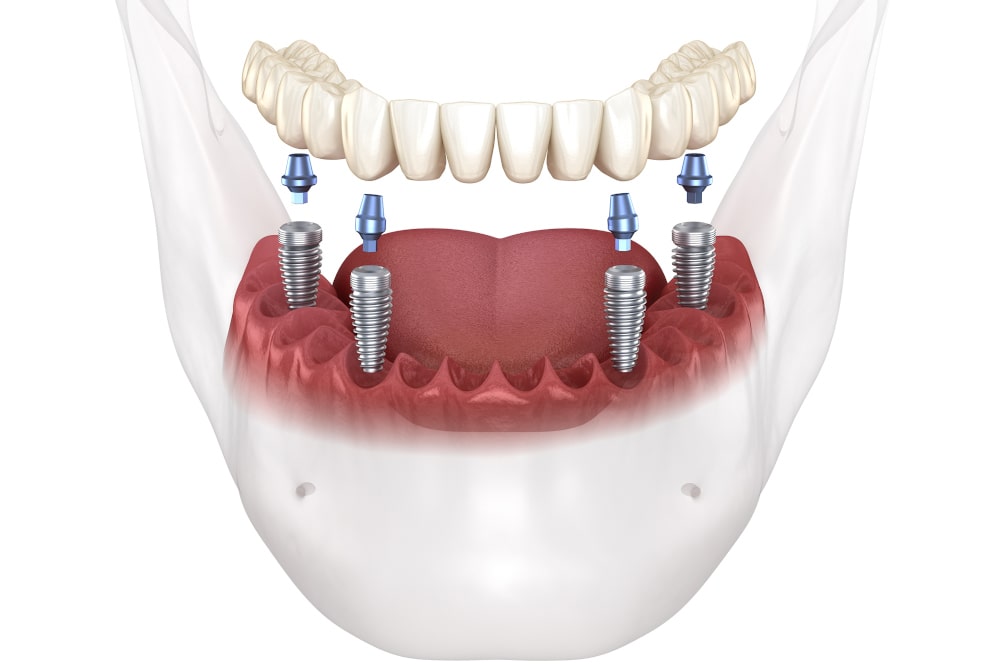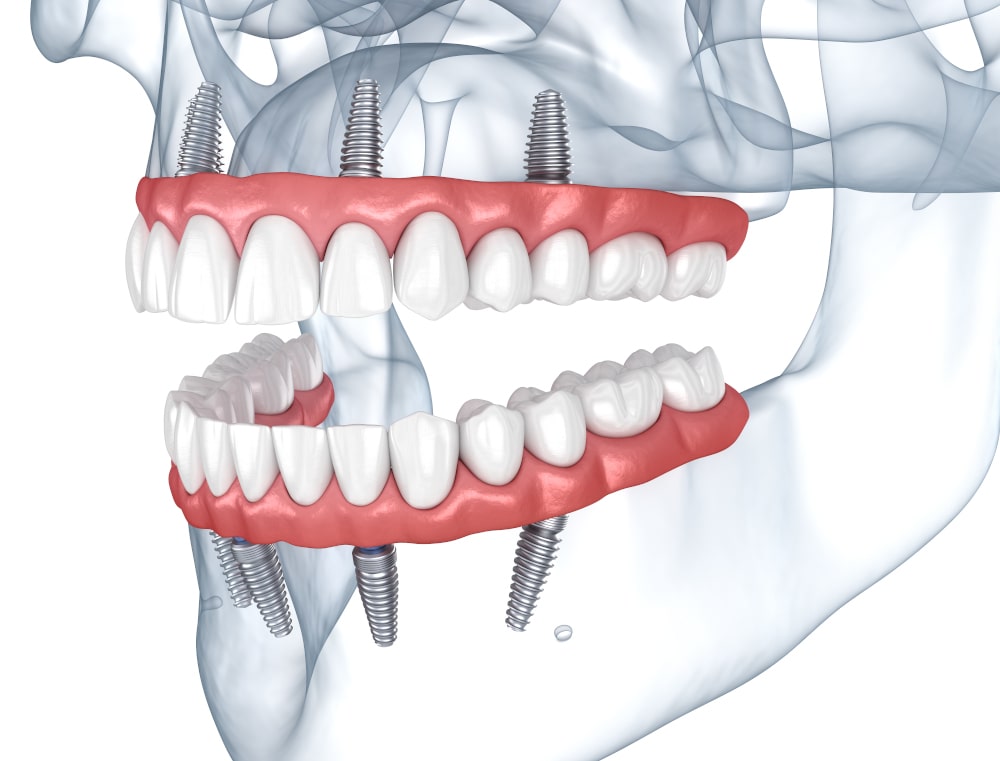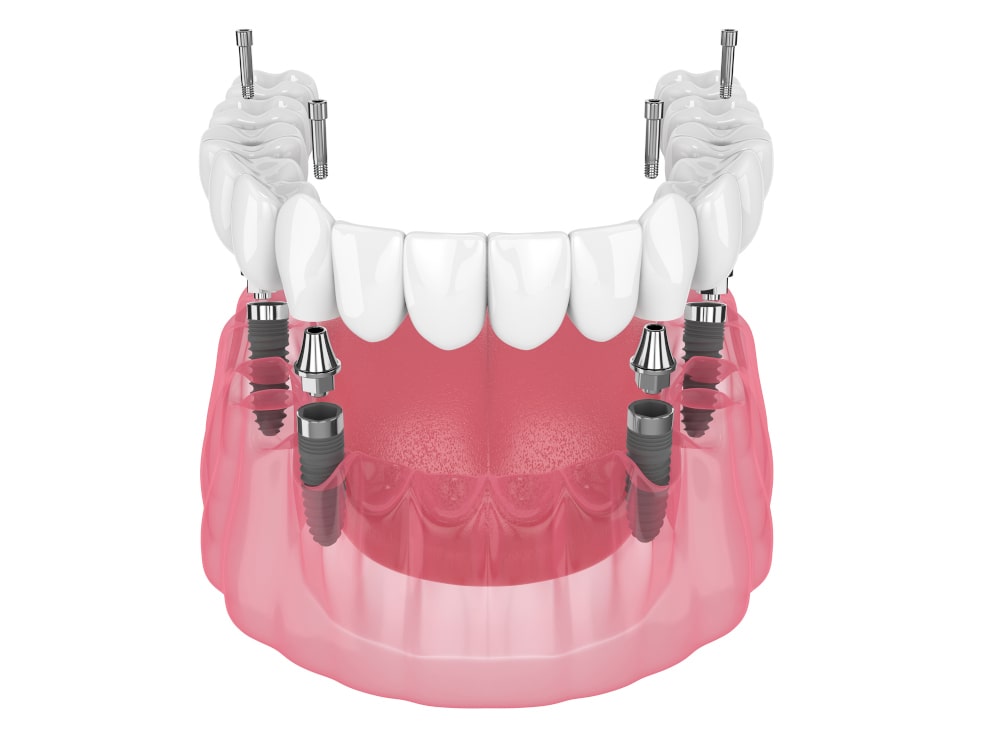
Key Takeaways
- "Permanent" dental implants refer primarily to the titanium posts surgically embedded in the jawbone, not necessarily the prosthetic teeth.
- All-on-4 dental implants can last 15 to 25 years or longer with proper care; however, the prosthetic components may need replacement sooner.
- Compared to other implant options, All-on-4 offers a balance of durability and practicality, often being a long-term or lifelong solution.
- The lifespan of an All-on-4 implant depends on several factors, including oral hygiene, bone health, the type of prosthetic material used, and regular dental follow-ups.
What does “permanent” mean when it comes to dental implants?
The term "permanent" in the context of dental implants often confuses. Many patients associate it with a lifelong guarantee, but in dentistry, "permanent" is a clinical term. It primarily refers to the implant post — the titanium screw placed into the jawbone that mimics a natural tooth root.
Implant Posts vs. Prosthetics: A Crucial Distinction
- Implant posts are typically made from medical-grade titanium and designed to fuse with the jawbone through a process called osseointegration. Once healed, they are considered a permanent fixture of the mouth.
- Prosthetic teeth (the visible part of the implant) are attached to these posts. These prosthetics are not permanent in the same way. Materials such as acrylic or porcelain wear over time and may require replacement.
So when dental professionals describe All-on-4 implants as permanent, they're referring to the posts embedded in the jawbone, not necessarily the teeth that sit atop them.
Context of All-on-4
With the All-on-4 procedure, four implants are placed in the jaw to support an entire arch of prosthetic teeth. While the implant posts are expected to last indefinitely if properly maintained, the prosthesis may need to be renewed every 10 to 15 years, depending on the material, wear, and patient habits, such as teeth grinding.
Longevity and Perception
Patients should understand that "permanent" doesn't mean immune to aging or damage. Think of it like a hip replacement — it's meant to last a long time, but it still requires care, and parts may need attention down the line.
Are All-on-4 implants considered a lifelong solution?
The short answer is that they can be, but it depends. Many patients live the rest of their lives with their original implant posts in place. However, prosthetics, gum health, and bone structure evolve, requiring occasional intervention.
Lifespan Compared to Other Implants
In contrast to single-tooth implants or removable dentures, All-on-4 provides a stable, fixed solution that supports an entire arch. Its design reduces the number of implants needed and allows for efficient support.
Average lifespan comparisons:
- All-on-4 implant posts: 20+ years, often lifelong, with good care.
- All-on-4 prosthetics: 10–15 years (may need replacement depending on material).
- Traditional single implants: 25+ years with excellent hygiene.
- Removable dentures: 5–8 years before relining or replacement.
According to Canadian Dental Association guidelines, implant longevity improves dramatically with regular maintenance and patient compliance.
Expert Insight
Dr. Jerry Jesin, DDS, co-founder of North York Smile Centre, explains:
"The All-on-4 approach is incredibly efficient and long-lasting. We've seen patients with implant posts going strong after 20 years. The key is not ignoring check-ups and keeping the surrounding tissues healthy."
Consider Patient-Specific Variables
The longevity of All-on-4 implants can also vary due to:
- Bone quality and density
- Presence of systemic conditions (e.g., diabetes, osteoporosis)
- Oral hygiene practices
- Smoking or alcohol use
- Night-time teeth grinding (bruxism)
In short, for many patients, All-on-4 is a practical lifelong solution, especially when oral hygiene is prioritized and prosthetics are monitored or updated as needed.
How long do All-on-4 dental implants last?
On average, All-on-4 implants last between 15 and 25 years, with some patients exceeding this range. But the difference between the implant and prosthetic components is crucial when evaluating lifespan.
Factors That Affect Duration
- Oral Hygiene:
- Daily brushing and flossing
- Use of water flossers to clean around the prosthetic base
- Regular professional cleanings and exams
- Bone Density:
- Patients with good bone volume are better candidates for long-term success
- Bone grafting may be required for others, slightly altering longevity outcomes.
- Prosthetic Quality:
- Acrylic prosthetics: Typically need replacement within 10–12 years
- Porcelain or zirconia options: Can last 15+ years, but are more expensive
- Lifestyle Factors:
- Smoking significantly reduces implant lifespan
- Diets high in sugar can contribute to peri-implantitis.
- Clenching/grinding accelerates wear.
Table: Comparison of Implant Options
| Feature | All-on-4 Implants | Single-Tooth Implants | Removable Dentures |
|---|---|---|---|
| Implant Post Longevity | 20–25+ years | 25+ years | Not applicable |
| Prosthetic Longevity | 10–15 years | 15–20 years | 5–8 years |
| Daily Maintenance | Moderate | Moderate | High |
| Stability | Fixed | Fixed | Removable |
| Bone Preservation | Yes | Yes | Minimal |
| Cost Efficiency (long term) | High | Moderate | Low |
What Patients Can Expect
Patients should anticipate follow-up visits to:
- Check implant integration and prosthetic condition
- Clean hard-to-reach areas under the prosthetic arch
- Evaluate gum health around the implant base.
Routine check-ins every 6 months and prosthetic adjustments every 10–15 years are part of maintaining that "permanent" result.

Do dental implants ever fail? What causes them to stop working?
While dental implants boast a success rate of over 95%, failures do occur. The timing and cause of failure significantly impact treatment outcomes. Understanding these factors can help patients minimize risk.
Early vs. Late Implant Failure
Early failure happens within the first few months, usually due to:
- Poor osseointegration (failure of the implant to bond with bone)
- Surgical trauma
- Infection at the implant site (peri-implant mucositis)
- Patient health conditions like uncontrolled diabetes
Late failure may occur years later and is often caused by:
- Bone loss due to gum disease (peri-implantitis)
- Mechanical stress from bruxism (teeth grinding)
- Poor prosthetic fit or misalignment
- Failure to attend follow-up cleanings and maintenance
Common Causes of Implant Failure
- Infection (Peri-implantitis)
- Similar to gum disease, it leads to the loss of bone and tissue.
- Often triggered by plaque buildup around the implant.
- Bone Loss or Insufficient Bone Support
- Can result from aging, systemic conditions, or poor implant placement
- Misalignment and Overloading
- A prosthetic crown that doesn’t align properly can stress the implant.
- Smoking
- According to the Canadian Dental Association, smokers are 2-3 times more likely to experience implant failure.
- Neglecting Oral Hygiene
- Increases bacterial load around the implant site
Is maintenance required for All-on-4 implants to stay “permanent”?
Absolutely. While All-on-4 implants are fixed in place, their longevity depends on proper care. Think of them like a car — reliable, but only with regular tune-ups.
Daily Cleaning Routine
- Brush your teeth twice daily with a soft-bristled electric toothbrush.
- Use a water flosser to flush debris beneath the prosthetic arch.
- Antibacterial rinses to minimize plaque accumulation
Weekly & Monthly Habits
- Clean with interdental brushes in any visible gaps
- Check for unusual odours, pain, or sensitivity.
Professional Maintenance Schedule
- Visit the dentist every 6 months for cleaning and evaluation.
- Imaging (X-ray or CBCT scans) every 2–3 years to check bone levels
- Adjustments or prosthetic replacement are typically needed every 10 to 15 years.
Expert Guidance
Dr. Rob Eisen, DDS, emphasizes:
"The mistake some patients make is thinking that because it's not removable, it's maintenance-free. It's the opposite — it requires dedicated hygiene, just like natural teeth."
What role does oral hygiene play in how long dental implants last?
Oral hygiene isn’t just helpful — it’s essential. Neglecting implant care can lead to peri-implantitis, a destructive inflammatory condition that causes bone loss and implant failure.
What Is Peri-Implantitis?
It resembles gum disease but occurs around implant posts. Signs include:
- Redness or swelling
- Bleeding during brushing
- Foul taste or odour
- Loosening of the prosthetic
If untreated, peri-implantitis may result in irreversible damage.
Best Practices for Implant Users
- Electric toothbrushes are more effective than manual ones
- Use low-abrasion toothpaste to protect prosthetics.
- Avoid smoking and reduce alcohol consumption.
- Clean under the prosthesis daily with a water flosser.

Can the prosthetic part of an All-on-4 implant be replaced if it becomes damaged?
Yes, and it’s relatively common. The prosthetic bridge in an All-on-4 system is designed to be replaceable while keeping the implant posts intact.
What Gets Replaced vs. What Remains
| Component | Typical Lifespan | Replaceable? | Notes |
|---|---|---|---|
| Titanium Implant Posts | 20–25+ years | Rarely | May last a lifetime with no intervention |
| Prosthetic Bridge | 10–15 years | Yes | Can be replaced if worn, cracked, or loose |
Common Reasons for Prosthetic Replacement
- Fractures from excessive grinding (bruxism)
- Aesthetic wear or discoloration
- Upgrading to stronger materials like zirconia
- Loosening due to gum or bone changes
Replacing the prosthetic does not require surgery if the posts are healthy. It’s typically an in-office procedure involving impressions and reattachment to the existing implants.
How do All-on-4 implants compare to traditional dentures long-term?
Over a 10- to 20-year span, All-on-4 implants often outperform dentures in comfort, stability, and oral health.
Long-Term Comparison Table
| Feature | All-on-4 Implants | Traditional Dentures |
|---|---|---|
| Stability | Fixed in place | Removable; may shift |
| Comfort | Natural-feeling | May cause sore spots |
| Maintenance | Moderate | High (daily removal, soaking) |
| Bone Preservation | Yes | No |
| Replacement Frequency | 10–15 years (prosthetic) | 5–8 years |
| Initial Cost | Higher upfront | Lower upfront |
| Long-Term Value | Higher | Lower due to more replacements |
Research-Backed Pros & Cons
Pros of All-on-4:
- Better chewing efficiency
- Less bone loss over time
- Greater self-confidence
Cons of All-on-4:
- Costlier initially
- Requires minor surgery
- Regular hygiene is essential.
Is there a warranty or guarantee for All-on-4 dental implants?
Yes, but coverage varies. Most reputable clinics and manufacturers offer warranties ranging from 5 to 10 years or more, with specific conditions.
Typical Warranty Breakdown
| Component | Warranty Duration | Covered Issues | Common Conditions |
|---|---|---|---|
| Titanium Implants | 10+ years | Material failure, fracture | Good hygiene, follow-up visits |
| Prosthetic Bridge | 5–10 years | Cracks, delamination | Avoid bruxism, no neglect |
| Abutments/Connections | 5–10 years | Loosening, breakage | Regular cleanings required |
What’s Often Not Covered
- Accidental damage (falls, trauma)
- Neglected oral hygiene
- Failure due to uncontrolled medical conditions
- Smoking-related complications
Important Notes
Always ask your provider for:
- Written in terms of warranty
- Manufacturer documentation
- Maintenance requirements to keep the warranty valid
Most importantly, follow-ups every 6 months are often mandatory for warranty retention.
How often should I visit the dentist after getting All-on-4 implants?
Consistent follow-up visits are essential to ensure the long-term success of All-on-4 implants. The care schedule isn’t complicated, but skipping appointments can reduce the longevity of the system.
Year-by-Year Guide
First Year After Surgery:
- Initial check-up: 1 week after surgery to assess healing
- First cleaning & exam: 1 month post-surgery
- Second cleaning: 3 months later
- Follow-up: 6 months post-surgery (may include X-rays)
Ongoing Schedule:
- Every 6 months: Standard cleaning and prosthetic inspection
- Every 2–3 years: Imaging (CBCT or X-ray) to assess bone structure
- Every 10–15 years: Prosthetic evaluation and possible replacement
Deep Cleaning Intervals
Deep cleaning (debridement around the implants) is typically needed once a year or more frequently for patients with:
- Gum sensitivity or inflammation
- Diabetes or systemic issues
- Heavy plaque buildup or tartar retention
Are All-on-4 implants permanent?
All-on-4 implants offer a strong, lasting solution; however, permanence depends on proper care, not just the materials used. The titanium posts can last a lifetime, while the prosthetic bridge may need to be replaced every decade or so.
Summary Table
| Component | Lifespan | Maintenance Need |
|---|---|---|
| Titanium Posts | 20–25+ years | Minimal if the bone remains stable |
| Prosthetic Bridge | 10–15 years | Replace if worn/damaged |
| Oral Hygiene | Daily | Essential for longevity |
| Dental Check-Ups | Every 6 months | Prevents complications |


